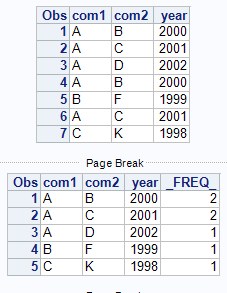- Home
- /
- Solutions
- /
- Data Management
- /
- Re: retaining unique combinations
- RSS Feed
- Mark Topic as New
- Mark Topic as Read
- Float this Topic for Current User
- Bookmark
- Subscribe
- Mute
- Printer Friendly Page
- Mark as New
- Bookmark
- Subscribe
- Mute
- RSS Feed
- Permalink
- Report Inappropriate Content
hi,
suppose that I have the following table:
| com1 | com2 | year |
|---|---|---|
| A | B | 2000 |
| A | C | 2001 |
| A | D | 2002 |
| B | A | 2000 |
| B | F | 1999 |
| C | A | 2001 |
| C | K | 1998 |
please note that the combinations A-B and A-C are present 2 times each, so what I would like to do is to include each combination only once and get the following table:
| com1 | com2 | year |
|---|---|---|
| A | B | 2000 |
| A | C | 2001 |
| A | D | 2002 |
| B | F | 1999 |
| C | K | 1998 |
thank you!
Accepted Solutions
- Mark as New
- Bookmark
- Subscribe
- Mute
- RSS Feed
- Permalink
- Report Inappropriate Content
input (com1 com2)(:$1.) year;
cards;
A B 2000
A C 2001
A D 2002
B A 2000
B F 1999
C A 2001
C K 1998
;;;;
run;
data scom;
set com;
call sortc(of com:);
run;
proc print;
run;
proc summary data=scom nway;
class com: year;
output out=unique(drop=_type_);
run;
proc print;
run;

- Mark as New
- Bookmark
- Subscribe
- Mute
- RSS Feed
- Permalink
- Report Inappropriate Content
The only way I know of is the manual way, which is probably what you are trying to avoid. The fastest way I know of is to insert all combinations into a "already used table", then do a lookup on it.
- Mark as New
- Bookmark
- Subscribe
- Mute
- RSS Feed
- Permalink
- Report Inappropriate Content
Switching data values around would work:
data halfway_there;
set have;
if com1 > com2 then do;
dummy = com1;
com1 = com2;
com2 = dummy;
end;
drop dummy;
run;
proc sort data=halfway_there out=want nodupkey;
by com1 com2;
run;
Possibly you want the final sort BY COM1 COM2 YEAR, but that is up to you.
I would bet the SQL programmers out there can do it in one step, along the lines of:
min(com1, com2) as com1, max(com1, com2) as com2
in combination with SELECT DISTINCT. I know the experiments I would try, but I'm not well versed enough to write out the code off the top of my head.
Good luck.
- Mark as New
- Bookmark
- Subscribe
- Mute
- RSS Feed
- Permalink
- Report Inappropriate Content
input (com1 com2)(:$1.) year;
cards;
A B 2000
A C 2001
A D 2002
B A 2000
B F 1999
C A 2001
C K 1998
;;;;
run;
data scom;
set com;
call sortc(of com:);
run;
proc print;
run;
proc summary data=scom nway;
class com: year;
output out=unique(drop=_type_);
run;
proc print;
run;

- Mark as New
- Bookmark
- Subscribe
- Mute
- RSS Feed
- Permalink
- Report Inappropriate Content
data want;
set have;
length string $200.;
retain string;
if index(string,catx('-',com1,com2))=0 then output;
string=catx(',',string,catx('-',com2,com1));
drop string;
run;
April 27 – 30 | Gaylord Texan | Grapevine, Texas
Registration is open
Walk in ready to learn. Walk out ready to deliver. This is the data and AI conference you can't afford to miss.
Register now and lock in 2025 pricing—just $495!
Need to connect to databases in SAS Viya? SAS’ David Ghan shows you two methods – via SAS/ACCESS LIBNAME and SAS Data Connector SASLIBS – in this video.
Find more tutorials on the SAS Users YouTube channel.


